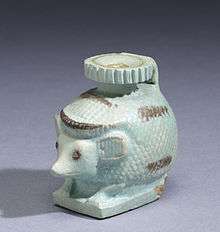Aryballos
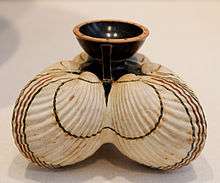
An aryballos (Greek: ἀρύβαλλος; plural aryballoi) was a small spherical or globular flask with a narrow neck used in Ancient Greece.[1] It was used to contain perfume or oil, and is often depicted in vase paintings being used by athletes during bathing. In these depictions, the vessel is at times attached by a strap to the athlete's wrist, or hung by a strap from a peg on the wall.
The shape of the aryballos originally came from the oinochoe of the Geometric period of the 9th century BCE, a globe-shaped wine jar. By the Proto-Corinthian period of the following century, it had attained its definitive shape, going from spherical to ovoid to conical, and finally back to spherical. This definitive form has a wide, flat mouth, and a single small handle. Some later variations have bell-shaped mouths, a second handle, and/or a flat base. Potters also created inventive shapes for aryballoi.
Gallery
-
Cypriotic geometric white painted ware, 850–750 BC
-
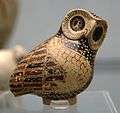
Owl-shaped, Proto-Corinthian, 630 BC
-

575–550 BC (Louvre)
-
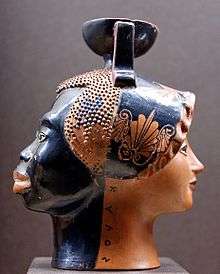
Janiform with kalos inscription, 520 BC
-

Foot-shaped, c. 500 BC
-
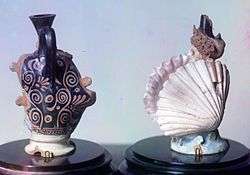
Ancient Etruscan "aryballoi" terracotta vessels unearthed in the 1860s at Bolzhaya Bliznitsa tumulus near Phanagoria, South Russia (then part of the Bosporan Kingdom of Cimmerian Bosporus); on exhibit at the Hermitage Museum in Saint Petersburg.
- ^ From the workshop of the Douris Painter. On the back two kalós love-inscriptions declare that Thodis and Chairippos are handsome. Exhibited in Room 8 of the Kerameikos Archaeological Museum (Athens).
See also
References
| Wikimedia Commons has media related to Aryballoi. |
- ↑ "aryballos" in The New Encyclopaedia Britannica. Chicago: Encyclopaedia Britannica Inc., 15th edn., 1992, Vol. 1, p. 611.
